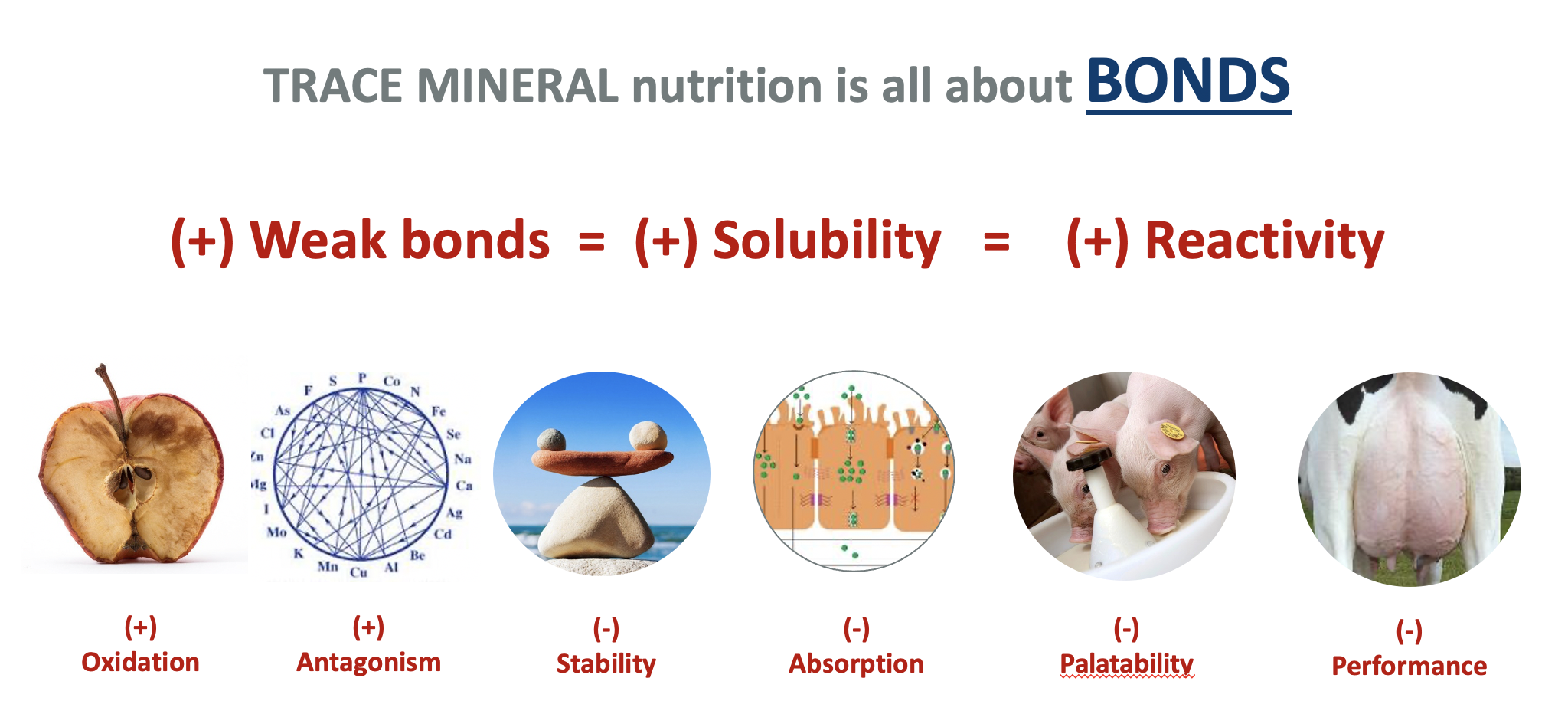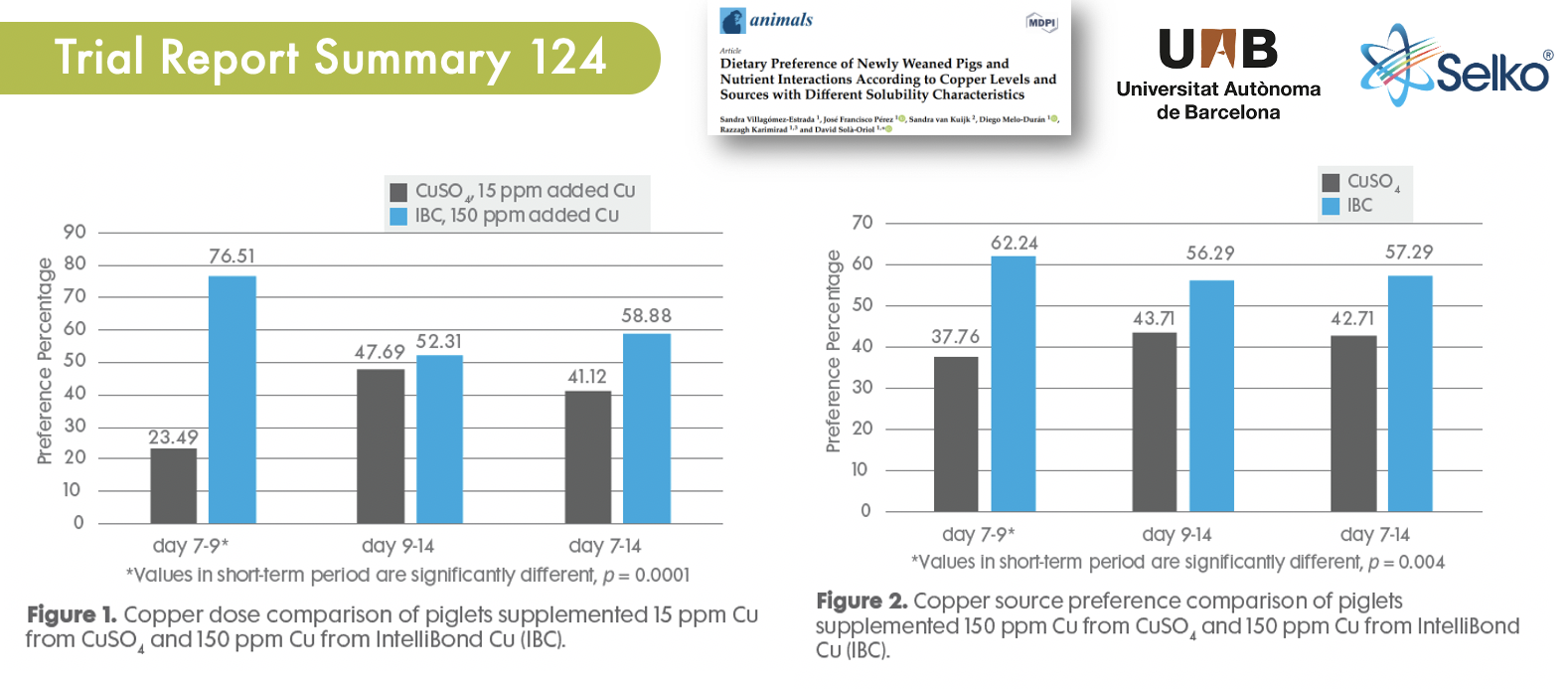



Functional Feeds: Making Trace Minerals Palatable for Pigs
The source of trace mineral can play a role in helping or harming feed palatabilityPalatability research in swine has demonstrated that mineral source influences feed intake. Research finds that reactive mineral sources, like sulphate-based trace minerals, can change the flavour profile and reduce feed intake, especially when high levels are present in pre- and post-weaning diets. Use of less reactive trace minerals - like hydroxychloride-based trace minerals - can support or even improve intake of feed for young swine. Establishing and supporting strong feed intake early in life can help animals reach their full potential as seen in better adaptation following weaning, along with stronger weight gain earlier and throughout the production process.
Trace mineral development
As livestock genetics have improved, animals have started to require higher levels of nutrients than are available in feed ingredients alone. This requirement is prompting the use of supplements including additive trace minerals. Trace mineral types also have seen development advancement since their initial use decades ago. Advances in feed additive technologies have improved mineral bond stability and bioavailability while reducing reactivity (Figure 1). Established in the mid-1990s, hydroxychloride trace minerals provide a more stable covalent bond that is not reactive to liquid at a neutral pH the way that sulphate-based trace minerals are. This insolubility aspect is of interest because weak metal bonds allow trace minerals to dissociate and leave metal ions free to interact with other dietary nutrients and potentially alter feed flavour. Additionally, hydroxy trace minerals have a higher metal concentration – 44-56% - than organic trace minerals and a lower price point.

Feed palatability - flavour, feed intake and feeding frequency
The taste of feed, especially for young animals, can be quite important as taste helps spur or suppress appetite and feed intake. Both ruminants and swine can taste different compounds – pigs have more taste sensors, or taste buds - than humans do, making palatability a priority. While swine can identify a range of flavours including bitter, sweet, sour, fatty or salty only certain flavours encourage pigs to keep eating. Other flavours, like bitter or salty, may prompt animals to slow or stop feed intake increasing the importance placed on feed palatability - especially with young animals learning to eat new feed.
One view of the role taste plays considers the short and long-term control of appetite involved. Short-term control relates to the size of the meal eaten at any one time, while long-term control looks at how often an animal eats or how much time occurs between meals. Feed taste and palatability help dictate how much animals eat, when they eat, how often they consume and how much.
With feed intake, certain flavours including bitter, sour and salty tastes could be related to problems with the material being eaten and often encourage an animal to slow or stop eating specific feeds, which means those flavour profiles should be avoided. (Figure 2)
Similarly, some types of trace mineral can alter feed intake by changing flavours and feed palatability. Soluble and reactive trace minerals, such as oxide and sulphate-based minerals, can start to dissolve in the mouth releasing metal ions and producing bitter or salty flavours and negatively influencing feed intake. Using a more neutral tasting and less reactive trace mineral source may be able to prevent the drop in feed intake from occurring and potentially improve feed intake.

Swine palatability research – copper intake insights from Spain and Kansas, USA
A series of studies explored the use and palatability of different types of trace mineral in swine feed. Early feeding habits help establish good feed intake during a pig’s lifetime. However, slow early feed intake can lead to digestive problems and low blood copper levels, which can prompt developmental problems.
A set of feeding trials done in at the Universitat Autonoma in Barcelona tracked the dietary preference of young pigs.2 In the first feeding trial, swine were offered two diets, one with 15ppm copper sulphate and one that included either 150 ppm copper sulphate or hydroxychloride copper. In the second, pigs could choose between diets supplemented with 150ppm copper sulphate or 150 ppm hydroxy copper (Figure 3).

Feeding trial results indicate that when given the choice between diets with copper sulphate at low (15ppm) or high (150ppm) levels and high levels of hydroxy copper (150ppm) swine are more likely to eat feed with hydroxy copper – especially in the early period of the trial.
Diets in both trials also contained 500 units of phytase and an in vitro assessment of copper source, solubility, and interaction with phytase was conducted. At a neutral pH, similar to what would be found in the mouth, copper sulphate almost completely dissolved while hydroxy copper saw less than 20% solubility. However, at a pH of 2.5, like what would be found in the gut, both copper sulphate and hydroxy copper completely dissolved (Figure 4).

Researchers also tracked phytic phosphorus solubility at a neutral pH (6.5) when copper sulphate or hydroxy copper was present. Copper sulphate reduced solubility of phytic phosphorus, while its levels stayed predominantly consistent when combined with hydroxy copper. This will allow the added phytase to break down more of the phytic phosphorus, as it is only available to the enzyme when it is in solution.
Similarly, a feeding trial conducted in 2016 tracked feed intake and swine preference when provided diets containing 160ppm copper and 110ppm zinc from either a sulphate or hydroxychloride source for a 34-day period.3 Pigs consumed more of the feed with hydroxy-based trace mineral throughout the length of the trial but were especially likely to consume the feed from days 0-14.
A study conducted at Kansas State University looked at preference in older pigs and tracked diet selection by grower-finisher animals.4 in the trial, 150 pigs were provided one of three diets – a control with no additional copper, and two experimental diets with 150ppm copper from either a sulphate or hydroxychloride source. Pigs were provided options between either the control and copper sulphate, the control and hydroxy copper, or copper sulphate and hydroxy copper. Results of the palatability trial found that swine preferred the diet with no added copper, but when choosing between the control and a supplemented feed more were willing to eat the feed containing hydroxy copper. However, when pigs picked between the two supplemented feeds the diet containing hydroxy copper was almost twice as popular (Figure 5).

Improving the palatability of feeds, especially for young swine is important for the animal’s long-term development and performance. A study done in 2017 tracked feed intake during early life and found that improved feed intake pre-weaning spurred better daily gain through the post-weaning period.5 By day 42, animals that started with higher feed intake and receiving feed with hydroxy copper weighed an additional 1.6 kg.
Improving feed palatability before weaning helps establish better feed intake, higher daily gain, and improved performance for pigs throughout production. Any boost to feed intake before weaning supports post-weaning growth and can provide significant reduction in total days to market.
Conclusion
As feed contains flavours that animals avoid, feed intake may decrease in the presence of such flavours. These tastes can include bitter, sour, and salty flavours, similar to flavours released by highly soluble trace minerals. As such, sulphate-based mineral inclusion produces an adverse response for several species when the additives are present in feed, while use of less reactive trace minerals such as IntelliBond hydroxychloride minerals can support or increase feed intake.
In reviewing the findings, researchers concluded that calves and pigs prefer to consume more stable trace mineral sources such as IntelliBond over sulphate or also over organic trace minerals across a variety of supplementation stages and strategies. Increased preferential intake and palatability as a result of stable, non-reactive trace mineral source supplementation can help lead to greater performance results including higher feed intake, daily gain and also body weight at and after weaning. Research shows that higher weaning weights also result in higher lifetime performance in swine and ruminant species.









